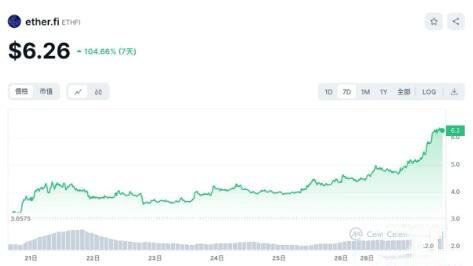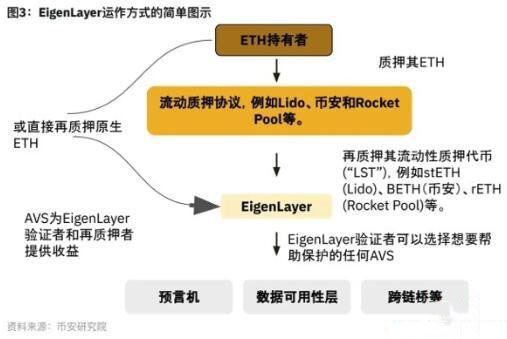The current total lock-up value (TVL) exceeds $3 billion, making Etherfi ($ETHFI) the leader in the liquidity re-pledge track. It has been listed in mid-March. Ann (Binance). $ETHFI peaked at around $5.3 when it was first listed, and later fell back to fluctuate between $2 and $4.
Recently, Etherfi has suddenly risen rapidly. As of the time of writing today (27th), it once rose to $6.43, setting a record high, with a one-week increase of 104.66%. Etherfi recently announced the launch of the second quarter airdrop points activity, which may be a major boost to the currency price.

For some projects, although they are not as high-profile as Solana and AI tokens, they can also bring convenience to retail investors. However, these projects are often ignored by institutions and DeFi researchers. For example, a well-known DeFi researcher wrote "DeFi Degen's Bull Market Guide" at the end of last year, and now he has mentioned the re-pledge track. In contrast, these neglected projects have become one of the most watched objects in this bull market.
In recent months, the Ethereum re-staking track has grown rapidly. If you still don’t know what re-staking is, this article will briefly introduce the three important re-staking projects with the largest lock-up volume on Ethereum, allowing you to understand the leaders of the re-staking track at once. First of all, the first re-pledge project of Ethereum 2.0 is Lido. As a decentralized, non-custodial solution, Lido anchors Ethereum’s ETH assets with StakeHound’s Token, providing users with liquidity and instant returns. Its lock-up volume has been rapid
After Ethereum transitioned from Proof-of-Work (PoW) to Proof-of-Stake (PoS) mechanism, Liquidity Staking (LST) has been the key to Ethereum DeFi important track in the field. Lido and Rocket Pool are both commonly used staking projects. For example, users who pledge Ethereum (ETH) on Lido will receive stETH pledge certificates and receive annualized interest on a regular basis.
EigenLayer was born and proposed the concept of re-pledge (Restaking). Allow users holding stETH and rETH (Rocket Pool) to stake again on EigenLayer (you can also choose to stake with native $ETH). EigenLayer's goal is to solve the problems of decentralized blockchain security and the difficulty of establishing a consensus network, and to promote the development of active verification service providers (AVS).
In the Ethereum blockchain, the proof-of-stake consensus mechanism is mainly created through the system of pledging $ETH.
However, for new projects, it is very difficult to establish a PoS consensus mechanism like Ethereum, and the process of generating sufficient security is also very time-consuming, and may not be as secure as Ethereum. EigenLayer solves the above problems by gathering the security of large public chains such as Ethereum and providing it to other decentralized applications (dApps).
In order to attract user investment, EigenLayer has also launched a points system to build airdrop expectations, but it has not yet announced when it will officially issue coins or airdrops.
Binance Research has written a report detailing the operation of EigenLayer. You can refer to the picture below:

According to previous reports by "CoinDesk", the developer of EigenLayer Eigen Labs has secured the favor of venture capital firm a16z, which helped lead a $100 million investment. DeFiLlama data shows that EigenLayer's total locked-up value has reached US$12.1 billion, growing rapidly after February this year.
After the emergence of EigenLayer, the Ethereum DeFi platform began to create business opportunities around the concept of re-pledge, and Etherfi led the Liquidity Re-pledge Track (LRT) of faucet.
What is liquidity re-pledge? To put it simply, users can get eETH (LRT) by staking native $ETH or stETH and other tokens on Etherfi, and at the same time receive Etherfi loyalty points and EigenLayer points.
If you want to withdraw and pledge again, Etherfi allows users to exchange eETH back to $ETH or stETH at any time, which is very convenient for users who pursue liquidity.
This kind of narrative of eating two fishes and having leveraged investment benefits has attracted many Ethereum users. Even Justin Sun, the founder of Tron Chain, deposited 20,000 before the end of Etherfi’s first airdrop event. of $ETH and successfully obtained nearly 3.5 million tokens.
Etherfi’s non-custodial re-pledge model has also been favored by BitMEX founder Arthur Hayes, who not only issued a document recognizing the potential of the project, but also participated in investment through his family office fund Maelstrom.
In addition to Etherfi, there are also many re-pledge projects that are competing for market share. DeFiLlama data shows that the following three projects are among the top in lock-up volume:
Renzo: The current lock-up volume reaches US$1.7 billion, ranking second in the re-pledge market. Renzo supports re-staking on multiple chains such as Ethereum, Arbitrum, Blast, and Binance Smart Chain (BSC). In January this year, Renzo announced the completion of US$3 million in financing, and the next month Binance Labs also announced its participation in investment.
Puffer: The current locked-up amount reaches US$1.3 billion, ranking third in the re-pledge market. Like Renzo, Puffer is backed by Binance Labs. Different from other re-staking projects, users who participate in Puffer re-staking and obtain the native liquid staking token (nLRT) pufETH can receive both traditional PoS verification rewards and re-staking rewards, while other projects generally provide rewards related to their native tokens. points reward.
Kelp DAO: The current locked-up amount reaches US$700 million, ranking fourth in the re-pledge market. Kelp DAO is a multi-chain liquidity staking platform. The founder has previously founded the liquidity staking project Stader Labs. Kelp DAO also has a reward mechanism. The airdrops received by users depend on the number of re-stakes and the number of days of staking.
Faced with the rapid development of the re-staking track, Binance Research believes that even though many people believe that re-staking can be the foundation of the blockchain ecosystem Facilities bring about great changes, but the beginnings of new technological developments and the emergence of new companies are often fraught with risks. In fast-moving, innovative emerging markets, surprises are not inevitable, and participants must carefully consider the possibility of risks.
As more AVS are expected to be officially launched this year, more and more different slashing conditions (punishment mechanisms) may appear, so it will become very important to choose which platform to use for re-staking. Binance Research also observed that liquidity restaking projects can handle large amounts of $ETH (or LST) and delegate them to different validators. This means that these projects can become key stewards of Ethereum’s decentralization if they choose to do so.
The above is the detailed content of What is re-pledge? Taking stock of the three leading re-pledge projects on Ethereum. For more information, please follow other related articles on the PHP Chinese website!




